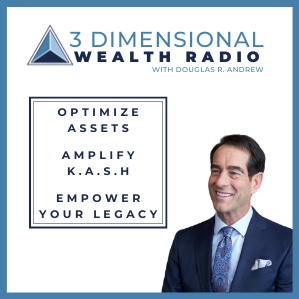When it comes to retirement, how can you ensure your financial vehicle won’t lose money due to market volatility? Put on your seatbelt. You’re about to gain critical knowledge that can accelerate your financial future.
This is part seven out of a 21-topic series titled, “Secrets to A Tax-Free Retirement.” Invest time in this series (and in my book, “The LASER Fund,” which you can order free—more details below) and you could accumulate up to an extra million bucks that could generate up to $100,000 a year income-tax-free for as long as you live.
As a financial strategist for more than 45 years, I’m a big proponent of universal life insurance—but especially of indexed universal life (IUL).
Indexed universal life insurance didn’t arrive on the scene until about 1997. When it did, IUL was a no brainer for me. Personally, I chose indexed universal life over regular fixed universal life insurance from that point forward. By doing so, I tweaked my rates of return that had been averaging 8.2% up until 1997 to 10.07% by using indexing.*
Now, let me warn you. There are a lot of financial advisors who do not understand what I’m about to teach you, and they think I’m talking about indexed mutual funds. Not at all. Indexing is a strategy; insurance or mutual funds are the financial vehicles.
I’ll simplify the principles in this article, but if you’d like a more detailed explanation, it’s all in “The LASER Fund” book.
IUL BASICS
As a foundation, I explain some of the key strategies of this approach in other articles, such as how to properly fund a maximum-funded indexed universal life insurance policy, or what I call a LASER Fund.
I outline how we maximum fund the insurance policy to put the most money in that the IRS will allow, with the least amount of insurance they will let us get away with, as fast as we can (all to align with tax laws like TEFRA/DEFRA and TAMRA).
So let’s say I have $500,000 to set aside for retirement. I put in $100,000 a year for five years. That $500,000 is my basis, or the Guideline Single Premium.
And let’s say that I am earning on average 10% (the historical average has been 5% to 10%). My $500,000 is earning 10%, and it doubles in 7.2 years. Now I have $1 million of cash value inside my indexed universal life insurance policy.
With indexed universal life, you have the ability and flexibility to be able to just hunker down and play it safe anytime you want and get the General Account Portfolio rate.
Let’s say the insurance company, on all of its billions or even trillion dollars of assets in their General Account Portfolio (GAP), is earning 6%, and they need 1% for their overhead, so the net is 5%. Now, from 2000 to 2012, the GAP rate was at least 5% or greater. To be conservative, let’s use that 5% (since those years included The Great Recession).
FEELING BEARISH OR BULLISH – YOU CAN DECIDE WHAT TO DO
Let’s say I feel bearish about America, and I think we’re going to head for a recession. I can play it safe and take the GAP rate of 5%. On my $1 million, I would end up with a $50,000 return.
Now, I’ve got $150,000 growing the next year. Let’s say I feel bullish about America this year.
To illustrate, let’s say it’s November of 2011, November. (Any idea why? It was an election year. What was different about that year? The incumbent, Obama, was running for a second term. I have found that in history, anytime an incumbent—Republican or Democrat–is running for their second term, they often do all kinds of things to stimulate the economy so they’ll get reelected.)
So let’s say on November 15th, 2011, I linked to the S&P 500 with a one-year point-to-point indexing strategy. A year later, November 15th, 2012, which was right after the election, we measured the growth in the S&P 500 during that time period.
Sure enough, it grew more than 16% during that time period, so I earned $160,000 from 2011 to 2012 on the million.
Great, right? Now you’re probably thinking, “How does indexing work?”
INDEXING BASICS
To explain, when you link to an index, your money is not actually IN the market, it’s simply LINKED TO the market. You’re essentially telling the insurance company, “I want a link to the S&P or the Dow Jones or the Russell 2000 or the Barclays.” Many insurance companies have 10 or 15 indexes you can choose from. You can often diversify, choosing more than one index. And you can also often choose the point-to-point strategy. Think of it like a measuring tape. Many strategies “measure” one-year point-to-point, but some are two years or five years. And many strategies have earning caps (or ceilings), while some do not. Plus, indexing guarantees a 0% floor during the down years. (All this is explained in “The LASER Fund” book, in Section I, Chapter 6.)
So in the illustration, by choosing to link my policy to the S&P 500 that year, I’m basically telling the insurance company, “Don’t risk my million. My million dollars will stay safe in your insurance company earning you the GAP of 5%, but I want you to pay me whatever the S&P does.”
How can they do that? You can’t believe how many people ask the question, “How can an insurance company afford to pay you 16% in that year when they’re only earning 5%?”
Are you ready for the answer? By indexing, you’re essentially telling the insurance company, “I’m willing to relinquish the guaranteed GAP return of 5%. I’m willing to give that up for the chance to earn more by linking to the S&P 500. Just pay me whatever the S&P does this year.”
The insurance company is smart; they wouldn’t do it if they didn’t have the wherewithal. They buy upside options in the S&P 500; in fact, they’re the number one purchaser of options in the world.
In this example, in 2012, the S&P increased by more than 16%, but since my indexing strategy had a cap, I earned 16%. I earned $160,000 from 2011 to 2012 on the million.
What’s the tradeoff? The S&P actually was higher than that, but the insurance company capped my earnings at 16%, because they don’t have my whole million to put at risk. My principal must stay safe in the insurance company. Since they only have the interest on my million to buy options, they have to cap me.
If I guessed wrong and the economy tanked in 2012 by 40% like it did in 2008, my million still would’ve been worth $1 million. My principal is protected by a 0% floor. We call this, “zero is your hero.”
Compare that to what would have happened if my money were in a variable universal life insurance policy or directly in the market. My million would’ve only been worth $600,000.
THE SAFETY AND POWER OF INDEXING
In 2008, I did not lose a dime of my money in my LASER Funds due to market volatility. Granted I did not make anything, but zero was my hero because I didn’t lose. Then in the first 90 days of 2009, I locked in, gained 16% the first 90 days after not losing a penny to market volatility the year before.
Do you know most Americans had to wait four years from 2008 to 2012 to make back the $400 grand they lost? Not me.
By the end of 2012 with indexing, a million that I had in the year 2000 was worth $3 million in 12 years. Everybody else in America, their million dropped down 40% twice and it took 12 years to get back what they had lost.
The bottom line: you can have far more money by using indexing because your money is not at risk in the market. Only the interest on your money buys options. If the market goes down, the options expire. Worthless, but you simply gave up the GAP rate of say 5%. You did not lose your principal.
I have discovered that throughout history, if I link to an index, because most decades you’ll have seven gain years versus three loss years, that decade 2000 to 2010 and another two years to 2012, we had five loss years. That means you would have been saved by the 0% floor five of those years.
You only made money the other five or seven years. Personally, I only capped out twice, but my average return from 2000 to 2010 was 7.23%; $1 million doubled to $2 million. But because I used indexing and I rebalanced, which I’ll talk about in another episode, I only earned 0% in 2001 and 2008, because I moved back over and earned 5% when the economy went haywire.
You don’t have to sit there and earn zero for two and three years in a row. You can just move back over and say, “Okay, just give me the guaranteed 5% next.” And then when you’re ready to link, you link and you can participate in the upside without the risk of losing if the market goes down.
So the key takeaway to this episode is that with indexed universal life, your money is safe in the insurance company earning the GAP rate, whether it’s 4%, 5%, 6%. Anytime you want to link to an index, you can do that and participate with the upside of the market. Your principal stays safe, so that if the market goes down, you don’t lose. You earn zero. You may not earn anything, but zero can be your hero.
Now, if this simplified explanation of indexing intrigues you, I invite you to learn more.
WANT TO LEARN MORE?
Watch the Video – Watch the related YouTube video to see me explain “What Is Indexed Universal Life (IUL) and How Does It Work” (and while you’re there, be sure to subscribe to my YouTube channel so you don’t miss a thing!).
Elevate Your Financial Dimension – Find out how you can improve your Financial Dimension journey and seize the liquidity, safety, predictable rates of return, and tax advantages of a LASER Fund. Explore the in-depth financial strategies and learn from real-life client experiences by claiming your free copy of “The LASER Fund” book at LASERFund.com. Just pay for shipping and handling, and we will send it to you, absolutely free.
Join a Webinar – Want to find out if a LASER Fund (a maximum-funded, properly structured indexed universal life insurance policy) is right for you? Join us for an upcoming webinar where you can explore these strategies.
*Important Note: Due to regulatory guidelines, you will often see a much more conservative approach illustrated when designing your policy. While I have personally averaged 10.07%, your experience will be different. The key is working with a qualified IUL Specialist who understands best practices needed to accomplish this. Most financial professionals have no idea how to do this.


